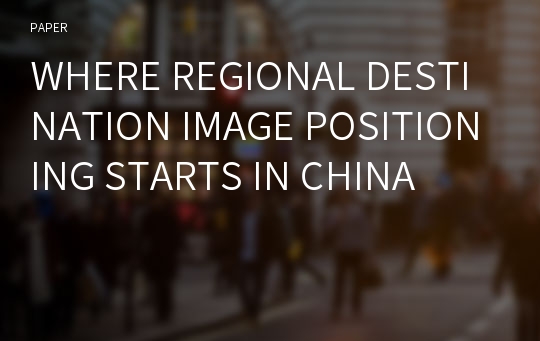WHERE REGIONAL DESTINATION IMAGE POSITIONING STARTS IN CHINA
* 본 문서는 배포용으로 복사 및 편집이 불가합니다.
서지정보
ㆍ발행기관 : 글로벌지식마케팅경영학회(GFMC)
ㆍ수록지정보 : Global Marketing Conference
ㆍ저자명 : Shasha Lin, Andreas H. Zins
ㆍ저자명 : Shasha Lin, Andreas H. Zins
영어 초록
During the past 40 years a huge number of studies investigated destination positioning and images from the tourists’ perspective, but by far fewer studies have been conducted from the destination managers’ perspective. In addition, few articles benchmark image positions between multiple destinations and their projections on marketing material. In order to generalize the results to larger geo-scopes, it is important to include a substantial number of destinations for analysis and take the influences of geography into consideration. The current study focuses on exploring positions of intended (planned) destination images. The primary aim is to compare the intended tourism image that is originally developed by destination managers of the sub-provincial districts in China and identify patterns of similarity and uniqueness behind. The research findings are expected to: (1) inform local destination managers in China about the current status of their destination tourism image positions compared with other destinations; and (2) give suggestions to the tourism administrations of both sub-provincial level and higher levels on how to better understand and coordinate the districts under their authorities and how to develop effective image positioning and projection strategies. In China, substitutability among tourism destinations like cities is growing, which is more obvious among those having same regional contexts, source markets and similar tourism products (Han & Tao, 2005). One remedy against this tendency is the development of strong image positions that are distinctive from other competing destinations. However, Chinese destination managers are facing several problems regarding positioning and marketing their destination images. First, the existing image positions of many destinations are unclear (Chen, 2008). Han and Tao (2005) point out that tourism images of many city destinations − in particular the mid-sized and small cities − are still on the organic stage and lack of systematic planning. What is more important is that many destination managers have not recognized the importance of image positioning and the benefits of induced image (Chen, 2008; Han & Tao, 2005). Second, some destinations have unrealistic image positions because they neglected market research opportunities and carried out positioning in a blind way (Chen, 2008). For instance, many destination managers think that destination image is the same as creative initiatives or slogans rather than the rational result from a systematic positioning process (Han & Tao, 2005). In China, DMOs are government departments traditionally. In other words, China National Tourism Administration (CNTA) is the DMO for whole China; Provincial Tourism Administrations (PTAs) manage provincial-level destinations and Municipal or County Tourism Administrations (RTAs) are the DMOs for sub-provincial districts (Feng, Morrison & Ismail, 2003; Li & Wang, 2010). In this study, when talking about China, “DMO” is exchangeable with “tourism administration”; and “destination manager” refers to the “senior officer working in the tourism administration”. District, province and region are three spatial levels frequently and consistently used in this study. In terms of the size, region is the largest whereas district is the smallest. A region contains one or several provinces. A province has several districts under its authority. In this research, the unit of analysis is sub-provincial districts that belong to provinces. The provinces are sorted into different geographical regions that are characterized by different categories of endowed tourism resources. This study adopts the most recent scheme developed by Song (1994). He classifies the tourism destinations in China into 10 TRG Regions and 77 sub-TRG Regions. TRG Regions consist of complete provinces. While the sub-TRG Regions focusing on market appeal may contain districts across provinces. Table 1 summarizes the features of the 10 TRG Regions and their included provinces; the regions names are the abbreviations of their included provinces. This research investigates intended image positions from the destination managers’ perspectives for sub-provincial districts in China. There are 27 provinces1 and 365 sub-provincial districts (SP Districts) in China. The 365 SP Districts are classified into 9 groups according to the scheme of tourism resources geographical regions (TRG Regions) reviewed before. Due to the different administration systems, the 10th region including Hong Kong, Taiwan and Macau is excluded from this research. 122 out of 365 SP Districts are selected. The sampling method combines multistage sampling, stratified sampling and simple random sampling. For only 83 districts (68%) relevant documents could be retrieved online. 48 documents represent the “Tourism Development Master Plans” and 35 documents the “12th Twelve-Five Year Tourism Development Plans”. Six districts did not mention any type of intended image positions in their development plans. The content about intended destination image position(s) – i.e. the most essential image position(s) for a district as a whole destination to differentiate itself from others – are identified from the tourism plans. The extracted content about image positions often appears in the formats of short sentences or phrases that contain more than one concept. Thus, the original extracted content is processed to identify all included image concepts that are distinct from each other. The content analysis yielded a spread of 164 different image items with only 189 occurrences for a total of 77 districts. So, on average, there are not more than about 2.5 image positions that can be identified in the tourism master plans or development plans of the sub-provincial districts. 20% of these plans use only one image concept; 38% two items, 26% three different items, 12% four and only 5% are using five items. To make this list more comprehensible the items were aggregated in two steps to 48 image factors. In almost each tourism master or development plan which discusses positioning of the district through promoting destination images cognitive or functional terms are used. About one third of these documents uses affective or psychological features. Yet, two thirds of the intended district images are completely lacking any affective element that could help identifying appealing spots on the touristic map among the functionally loaded clutter. Reviewing the coverage of intended image items through the conceptual lenses proposed by Tapachai and Waryszak (2000) it becomes evident that only functional, emotional and epistemic aspects can be found as targeted image elements. Travellers, though, are also using social and conditional criteria when it comes to destination choice (Zins, 2010; Zins & Prompitak, 2010). Despite the relatively scarce usage of intended image positions for each Chinese sub-provincial district it is worthwhile to condense the image profiles of these 77 districts further. The 2-way profile data of 48 image factors for 77 sub-provincial districts were subject to a non-hierarchical cluster procedure to identify similarities among the districts. Considering both, the homogeneity gain of additional clusters and the relative simplicity of interpretation (expressed by the wSSI) a solution with ten different groups of districts was accepted. A sketch of the main characteristics is depicted in Table 2. The largest image profile group pools 24 different districts (31%) from 7 different TRG regions. The other larger groups (number 10, 4, 5 and 2 in descending order of similarity to number 7) do not exhibit one single lead region which means that the TRG regions share a multitude of targeted image positions. The larger TRG regions with quite a number of districts (BTHS, GFH, SJZAJ and YGG; together 49 out of 77 districts) show some gravity into the profiles 7, 4 and 5 (cf. Table 2). However, the frequency is not large enough to claim that a particular region is uniquely represented by one of the identified condensed image profiles. The majority of districts within one TRG region shows targeted image positions that are more common with districts of other TRG regions. Overall, the geographic spread of relatively similar district images is larger across provinces than across regions, which appears plausible. Destination managers may perceive threats from their neighbouring districts that share similar context images and source markets. This drives them to develop differentiated positions in order to prevent direct competition. Officially, higher-level DMOs like provincial tourism administrations have to coordinate the tourism planning of the lower-level districts (Tourism Law 2013; GSTP, 2003).참고 자료
없음태그
"Global Marketing Conference"의 다른 논문
 THE ROLES OF GREEN PACKAGING IN UGLY FOOD PURCHASE INTE..22페이지
THE ROLES OF GREEN PACKAGING IN UGLY FOOD PURCHASE INTE..22페이지 THE IMPACT OF INDUCED AWE ON ETHICAL TOURIST BEHAVIORS5페이지
THE IMPACT OF INDUCED AWE ON ETHICAL TOURIST BEHAVIORS5페이지 A BIBLIOMETRIC ANALYSIS OF SPIRITUAL TOURISM RESEARCH15페이지
A BIBLIOMETRIC ANALYSIS OF SPIRITUAL TOURISM RESEARCH15페이지 SOCIAL NETWORK ANALYSIS AND RESPONSE TIME TESTING: CONS..11페이지
SOCIAL NETWORK ANALYSIS AND RESPONSE TIME TESTING: CONS..11페이지 THE EFFECTS OF PARA-SOCIAL INTERACTION ON ONLINE CELEBR..3페이지
THE EFFECTS OF PARA-SOCIAL INTERACTION ON ONLINE CELEBR..3페이지 THE INFLUENCE OF OPINION LEADERS ON DAILY DEALS USER’S ..3페이지
THE INFLUENCE OF OPINION LEADERS ON DAILY DEALS USER’S ..3페이지 HOW IMMERSIVE RETAILING AFFECTS CONSUMERS’ URGE TO BUY:..6페이지
HOW IMMERSIVE RETAILING AFFECTS CONSUMERS’ URGE TO BUY:..6페이지 KEY TO SUPERSTARDOM IN A GLOBALISED MARKET: THE ROLE OF..6페이지
KEY TO SUPERSTARDOM IN A GLOBALISED MARKET: THE ROLE OF..6페이지 A POST-PANDEMIC LOOK AT TOURISTS’ PERCEIVED COOLNESS OF..4페이지
A POST-PANDEMIC LOOK AT TOURISTS’ PERCEIVED COOLNESS OF..4페이지 EXTRACTING OFFLINE RETAIL SHOPPING PATTERNS: OLLABORATI..5페이지
EXTRACTING OFFLINE RETAIL SHOPPING PATTERNS: OLLABORATI..5페이지

























